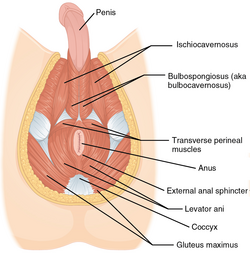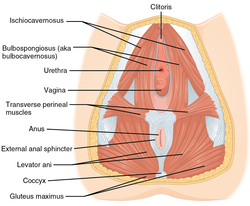| Transverse perineal muscles | |
|---|---|
 Muscles of male perineum (transversus perinei visible at center right). | |
 Muscles of the female perineum (transversus perinei visible at center right). | |
| Details | |
| Origin | Inferior rami of the ischium |
| Insertion | The deep transverse perineal muscle of the opposite side |
| Nerve | Pudendal nerve |
| Actions | Constricts urethra and vagina, maintains urinary continence |
| Identifiers | |
| Latin | musculus transversus perinei profundus, musculus transversus superficialis perinei |
| Anatomical terms of muscle | |
The transverse perineal muscles (transversus perinei) are the superficial and the deep transverse perineal muscles.
YouTube Encyclopedic
-
1/3Views:299 525797 56089 850
-
Pelvic Floor Part 2 - Perineal Membrane and Deep Perineal Pouch - 3D Anatomy Tutorial
-
Pelvic Floor Part 1 - The Pelvic Diaphragm - 3D Anatomy Tutorial
-
Male pelvis and perineum - plastic model
Transcription
Superficial transverse perineal
The superficial transverse perineal muscle (transversus superficialis perinei or Lloyd-Beanie muscle) is a narrow muscular slip, which passes more or less transversely across the perineal space in front of the anus.[1]
It arises by tendinous fibers from the inner and forepart of the ischial tuberosity and, running medially, is inserted into the central tendinous point of the perineum (perineal body), joining in this situation with the muscle of the opposite side, with the external anal sphincter muscle behind, and with the bulbospongiosus muscle in front.
In some cases, the fibers of the deeper layer of the external anal sphincter cross over in front of the anus and are continued into this muscle. Occasionally it gives off fibers, which join with the bulbocavernosus of the same side.
There are some variations: it may be absent or double, or insert into the bulbocavernosus or the external sphincter.
Deep transverse perineal
The deep transverse perineal muscle (transversus perinei profundus) lies in the perineum, a part of the pelvic floor. It arises from the inferior rami of the ischium and runs to the median plane, where it interlaces in a tendinous raphe with the other deep transverse perineal muscle of the opposite side.
The deep transverse perineal muscle is innervated by the pudendal nerve. The function of the muscle is fixation of the perineal body (central tendon of perineum), support of the pelvic floor, expulsion of semen in males and last drops of urine in both sexes.[2]
The deep transverse perineal muscle lies in the same plane as the urethral sphincter and formerly the two muscles were described together as the constrictor urethrae.
References
- ^ Maclean, Allan; Reid, Wendy (2011). "40". In Shaw, Robert (ed.). Gynaecology. Edinburgh New York: Churchill Livingstone/Elsevier. pp. 599–612. ISBN 978-0-7020-3120-5; Access provided by the University of Pittsburgh
{{cite book}}: CS1 maint: postscript (link) - ^ Saladin, Kenneth S. (2003). Anatomy & Physiology: The Unity of Form and Function (3rd ed.). McGraw−Hill. p. 354. ISBN 978-0072429039.
External links
- Anatomy photo:41:11-0103 at the SUNY Downstate Medical Center - "The Female Perineum: Muscles of the Superficial Perineal Pouch"
- Anatomy image:9148 at the SUNY Downstate Medical Center
- Anatomy image:9163 at the SUNY Downstate Medical Center
- Anatomy image:9172 at the SUNY Downstate Medical Center
